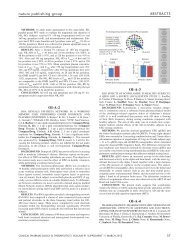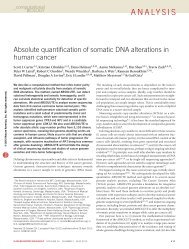open access: Nature Reviews: Key Advances in Medicine
open access: Nature Reviews: Key Advances in Medicine
open access: Nature Reviews: Key Advances in Medicine
Create successful ePaper yourself
Turn your PDF publications into a flip-book with our unique Google optimized e-Paper software.
RHEUMATOLOGY<br />
JIA. 6 They represent the first official treatment<br />
recommendations for JIA to be based<br />
on objective, validated methods, and have<br />
already been reviewed <strong>in</strong> this journal. 7 The<br />
term ‘recommendations’ was used, <strong>in</strong>stead of<br />
‘guidel<strong>in</strong>es’, to emphasize their nonprescriptive<br />
nature; the <strong>in</strong>tended aim of the publication<br />
was to support, but not to dictate,<br />
the <strong>in</strong>dividual physician’s decision. The<br />
recommendations are based on a comprehensive<br />
list of cl<strong>in</strong>ical scenarios, <strong>in</strong> which<br />
hypothetical patients are categorized on the<br />
basis of different comb<strong>in</strong>ations of key cl<strong>in</strong>ical<br />
parameters rele vant to the decision-mak<strong>in</strong>g<br />
process, such as disease activity and potential<br />
prognostic features.<br />
The ACR recommendations are a very<br />
useful tool, which can guide the treatment of<br />
patients with JIA, but will soon require updat<strong>in</strong>g<br />
given the rapid evolution of this field.<br />
Indeed, tocilizumab—an antibody aga<strong>in</strong>st<br />
the IL-6 receptor that has now been approved<br />
for the treatment of systemic JIA by both the<br />
FDA and the EMA—is not considered <strong>in</strong><br />
the recommendations. More over, trials are<br />
currently be<strong>in</strong>g performed <strong>in</strong> patients with<br />
systemic JIA that aim to <strong>in</strong>vestigate the efficacy<br />
of two IL-1 <strong>in</strong>hibitors, canak<strong>in</strong>umab (a<br />
monoclonal anti-IL-1 antibody) and rilonacept<br />
(the recomb<strong>in</strong>ant extracellular doma<strong>in</strong> of<br />
the human IL-1 receptor); the results of these<br />
studies will soon be available, and will presumably<br />
provide important new <strong>in</strong>formation<br />
re gard<strong>in</strong>g treatment of this disease.<br />
Although the <strong>in</strong>troduction of biologic<br />
therapies has represented a major advance<br />
<strong>in</strong> the treatment of JIA, the fact rema<strong>in</strong>s<br />
that the high costs associated with provision<br />
of these agents can be afforded only by<br />
the health care systems of a limited number<br />
of countries. 8 Around the world, most children<br />
with JIA have to rely on much less<br />
expensive drugs, such as methotrexate.<br />
Therefore, data regard<strong>in</strong>g the efficacy of<br />
comb<strong>in</strong>ation therapies compris<strong>in</strong>g methotrexate<br />
and other synthetic DMARDs <strong>in</strong><br />
compari son with metho trexate alone would<br />
be viewed with <strong>in</strong>terest by rheuma tologists<br />
worldwide. However, <strong>in</strong> contrast to rheumatoid<br />
arthritis—a dis ease <strong>in</strong> which many trials<br />
have supported the over all superiority of<br />
comb<strong>in</strong>ation DMARD therapy over methotrexate<br />
monotherapy 9 —data on combi nation<br />
DMARD therapy are lack<strong>in</strong>g for JIA.<br />
Important f<strong>in</strong>d<strong>in</strong>gs support<strong>in</strong>g the potential<br />
efficacy of comb<strong>in</strong>ation DMARD therapy<br />
<strong>in</strong> JIA were presented last year by Tynjälä<br />
et al. 10 The authors randomly assigned 59<br />
patients with early poly articular JIA to<br />
three treatment cohorts: <strong>in</strong>fliximab plus<br />
methotrexate; methotrexate alone; or methotrexate,<br />
sulfa salaz<strong>in</strong>e and hydroxychloroqu<strong>in</strong>e<br />
<strong>in</strong> comb<strong>in</strong>ation. The results of this<br />
trial showed that <strong>in</strong>fliximab plus methotrexate<br />
was su perior to comb<strong>in</strong>ation therapy and<br />
strik<strong>in</strong>gly superior to methotrexate alone. An<br />
<strong>in</strong>terest <strong>in</strong>g aspect of this study was, therefore,<br />
that synthetic DMARDs <strong>in</strong> combi nation<br />
seemed to be superior to metho trexate<br />
treatment alone, although the difference<br />
<strong>in</strong> effi cacy was not statistically significant.<br />
The study was, however, underpowered to<br />
show a signifi cant difference and the trend<br />
<strong>in</strong> favor of comb<strong>in</strong>ation therapy was consistent<br />
for all the endpo<strong>in</strong>ts tested. Thus, these<br />
results strongly suggest that comb<strong>in</strong>ation<br />
therapies with <strong>in</strong>expensive synthetic drugs<br />
could prove superior to methotrexate alone<br />
<strong>in</strong> future studies with appropriate sample<br />
sizes. The fund<strong>in</strong>g of these potentially very<br />
relevant <strong>in</strong>vestigator-<strong>in</strong>itiated randomized<br />
studies should represent a future priority for<br />
<strong>in</strong> ternational public fund<strong>in</strong>g bodies.<br />
2011 has witnessed important new advances<br />
<strong>in</strong> the understand<strong>in</strong>g and manage ment of JIA,<br />
but much rema<strong>in</strong>s to be done. In the future,<br />
more accurate classification of patients with<br />
JIA will be possible and more effec tive treatments<br />
will become avail able, ow<strong>in</strong>g to the<br />
<strong>in</strong>tegration of cl<strong>in</strong>ical data with the results of<br />
research <strong>in</strong>to dis ease pathogenesis.<br />
University of Genoa, Pediatria II e<br />
Reumatologia, Istituto G. Gasl<strong>in</strong>i, Largo G.<br />
Gasl<strong>in</strong>i 5, 16147 Genoa, Italy.<br />
albertomart<strong>in</strong>i@ospedale-gasl<strong>in</strong>i.ge.it<br />
Compet<strong>in</strong>g <strong>in</strong>terests<br />
The author declares no compet<strong>in</strong>g <strong>in</strong>terests.<br />
1. Petty, R. E. et al. International League of<br />
Associations for Rheumatology classification<br />
of juvenile idiopathic arthritis: second revision,<br />
Edmonton, 2001. J. Rheumatol. 31, 390–392<br />
(2004).<br />
2. Mart<strong>in</strong>i, A. Are the number of jo<strong>in</strong>ts <strong>in</strong>volved<br />
or the presence of psoriasis still useful tools<br />
to identify homogeneous disease entities <strong>in</strong><br />
juvenile idiopathic arthritis? J. Rheumatol.<br />
30, 1900–1903 (2003).<br />
3. Ravelli, A. et al. Ant<strong>in</strong>uclear antibody-positive<br />
patients should be grouped as a separate<br />
category <strong>in</strong> the classification of juvenile<br />
idiopathic arthritis. Arthritis Rheum. 63,<br />
267–275 (2011).<br />
4. Barnes, M. G. et al. Biologic similarities based<br />
on age at onset <strong>in</strong> oligoarticular and<br />
polyarticular subtypes of juvenile idiopathic<br />
arthritis. Arthritis Rheum. 62, 3249–3258<br />
(2010).<br />
5. Hirschfeld, S. & Sa<strong>in</strong>t-Raymond, A. Pediatric<br />
regulatory <strong>in</strong>itiatives. Handb. Exp. Pharmacol.<br />
205, 245–268 (2011).<br />
6. Beukelman, T. et al. 2011 American College<br />
of Rheumatology recommendations for the<br />
treatment of juvenile idiopathic arthritis:<br />
<strong>in</strong>itiation and safety monitor<strong>in</strong>g of therapeutic<br />
agents for the treatment of arthritis and<br />
systemic features. Arthritis Care Res.<br />
(Hoboken) 63, 465–482 (2011).<br />
7. Hashkes, P. J. Pediatric rheumatology:<br />
strengths and challenges of a new guide for<br />
treat<strong>in</strong>g JIA. Nat. Rev. Rheumatol. 7, 377–378<br />
(2011).<br />
8. Sawhney, S. & Magalhães, C. S. Paediatric<br />
rheumatology—a global perspective. Best<br />
Pract. Res. Cl<strong>in</strong>. Rheumatol. 20, 201–221<br />
(2006).<br />
9. Ma, M. H., K<strong>in</strong>gsley, G. H. & Scott, D. L.<br />
A systematic comparison of comb<strong>in</strong>ation<br />
DMARD therapy and tumour necrosis <strong>in</strong>hibitor<br />
therapy with methotrexate <strong>in</strong> patients with early<br />
rheumatoid arthritis. Rheumatology (Oxford)<br />
49, 91–98 (2010).<br />
10. Tynjälä, P. et al. Aggressive comb<strong>in</strong>ation drug<br />
therapy <strong>in</strong> very early polyarticular juvenile<br />
idiopathic arthritis (ACUTE-JIA): a multicentre<br />
randomised <strong>open</strong>-label cl<strong>in</strong>ical trial. Ann.<br />
Rheum. Dis. 70, 1605–1612 (2011).<br />
SLE IN 2011<br />
Decipher<strong>in</strong>g the role of NETs<br />
and networks <strong>in</strong> SLE<br />
Thomas Dörner<br />
From neutrophil extracellular traps to genetic networks that underlie the<br />
disease and new targeted therapies, important advances <strong>in</strong> 2011 improve<br />
our understand<strong>in</strong>g of the pathogenesis of systemic lupus erythematosus<br />
and mark the beg<strong>in</strong>n<strong>in</strong>g of our ability to treat it effectively.<br />
Dörner, T. Nat. Rev. Rheumatol. 8, 68–70 (2012); published onl<strong>in</strong>e 10 January 2012;<br />
doi:10.1038/nrrheum.2011.200<br />
2011 was a year of achievements <strong>in</strong> systemic<br />
lupus erythematosus (SLE)—for advances<br />
<strong>in</strong> basic and cl<strong>in</strong>ical research, and the translation<br />
of these f<strong>in</strong>d<strong>in</strong>gs <strong>in</strong>to daily cl<strong>in</strong>ical<br />
practice. After a decade of failures of some<br />
biologic therapies <strong>in</strong> SLE, the recog nition of<br />
particular cellular and cytok<strong>in</strong>e pathways as<br />
<strong>in</strong>volved <strong>in</strong> the pathogenesis has <strong>in</strong>itiated a<br />
promis<strong>in</strong>g period of progress <strong>in</strong> this complex<br />
disease. Many excellent contributions were<br />
published <strong>in</strong> 2011, but a few studies deserve<br />
emphasis for provid<strong>in</strong>g new perspectives.<br />
S68 | JANUARY 2012 www.nature.com/reviews








